Setting New Year’s resolutions often focuses on individual goals like losing weight or working out more. What about setting an attainable resolution to making the workplace a happier and healthier environment? Using self-awareness and personal development through the psychological model of the Johari Window provides a better understanding of employer and employee relationship that are possible in this new year.
A Look at the Johari Window
American psychologists Joseph Luft and Harry Ingham developed this model in 1955 while researching group dynamics. The model helps to achieve group understanding and enhance communication between group members. Conveniently combined, both Joe and Harry’s first names are used to name to model. It’s a fantastic method to look at feedback and self-awareness in the workplace and understand an individual’s perception on others. Through revealing information about oneself to others and learning from others, feedback forms mutual trust within the group.

Johari Window
Open Area
This area is an open book to oneself and to others. Think of areas easily shared on social media. Here people share openly items they are comfortable disclosing to others. It’s the skills, behaviors, emotions, feelings, and views that are known by everyone in the group.
Blind Spot
This is an area where others view the individual but they themselves are unaware of how they are seen or perceived. This area consists of small things like excessive hand gestures or saying “um” a lot, but the person remains unaware until it is pointed out. Reduction of this area is critical for group communications and growing trust.
Hidden Area
Everyone has personal information they do not want to reveal. This is the area of information guarded by others to remain private or hidden and away. Most people keep feelings of rejection, pain, sadness, and fear in this area and go to great lengths to keep it concealed.
Unknown
This area remains unknown to oneself and to others in a group and contains talents, capabilities, feelings, or information. A person remains unaware of this area until discovered or observed by others. For instance, a team member could have a talent with coding but because they were never taught this skill it remains an undiscovered talent. Additionally, this area could contain emotions from past traumatic experiences.
Johari Window in Real Life Setting
The Johari Window diagram show all four boxes similar in size, but in reality, when a new team member joins a team, the Hidden Area is much larger than the Open Area. For example, a new group member named Shawn joined the team. In the known area, teammates immediately got to know her hobbies, favorite sports team, and some feelings. The team assessed some of her blind spots with hand gestures she often made and things that she did that were irritating as well as the multiple areas where she excelled. The team did not know her Hidden Areas of embarrassment or shame, as well as family and marital problems. Lastly, Unknown to Shawn or her teammates, no one knew why she was not shy in certain circumstances, and there were several undiscovered talents and relationship patterns. Over time, each of the four boxes shifted in size through feedback and professional development.
Self Awareness and Personal Growth
In the new year, growing the Open Area occurs through both seeking advice and listening to the feedback. This helps improve effectiveness, resolves personal issues, answers problems, and builds more effective team relationships. Asking for feedback reduces the Blind Spots. When someone points out something small to a member, it moves that item from the Blind Spot to the Open Area. Members who are receptive to feedback, actively seeking it out, and honestly questioning how they are seen by others is a form of self-awareness and professional development. Recipients who both thank the person for providing them feedback and subsequently use feedback to make changes grow as individuals. An example of this is when an employer hears they, at times, are overly critical of others. Once the person is self-aware of this trait, they can examine the consequences of the behavior and decides whether to take action to change the behavior. Lastly, like turning the page into the new year, reduction of the Unknown occurs through both self-discovery and others’ observations. Using the Johari Window as a tool helps to develop oneself and increases team communication.



